#empress maria feodorovna the elder
Text
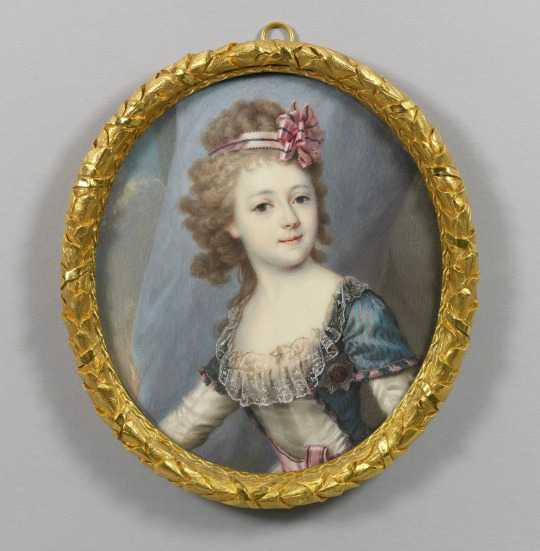



“My eldest daughter Alexandra is soft, sensitive and intelligent; she is very sweet, although not beautiful. But Elena is surprisingly good; she is extremely kind, but too playful. Maria has a brilliant mind and a beautiful heart, but her beautiful appearance was damaged by smallpox. Ekaterina, this one is a beautiful little doll, darling; very funny; the youngest, spoiled child of her mother.”
- Grand Duchess (later Empress) Maria Feodorovna of Russia on her four elder daughters, Grand Duchesses Alexandra, Elena, Maria, and Ekaterina, ca. 1791.
#empress maria feodorovna#grand duchess alexandra pavlovna#grand duchess elena pavlovna the elder#grand duchess maria pavlovna#grand duchess ekaterina pavlovna#romanov#russia#quotes
126 notes
·
View notes
Text
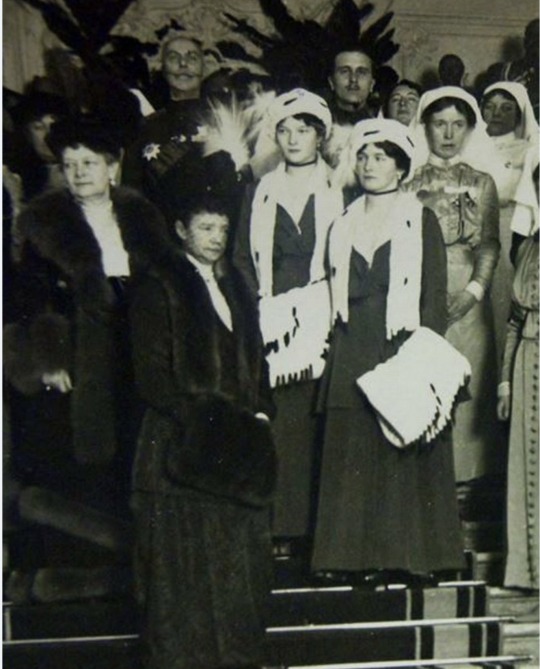
Simple Elegance: Grand Duchess Olga and Grand Duchess Tatiana
This is probably at some activity related to their hospitals during the war. Olga and Tatiana look beautiful but serious. In the photo also appear their Grandmother, the Dowager Empress Maria Feodorovna, and their aunt, Grand Duchess Maria Pavlovna the Elder (Miechen) - the older women look downright displeased.
#russian history#romanov dynasty#romanov family#imperial russia#Grand Duchess Olga Nicholaevna#Grand Duchess Tatiana Nicholaevna#Grand Duchess Maria Pavlovna the Elder#Empress Maria Feodorovna#vintage photography#simple elegance
18 notes
·
View notes
Text


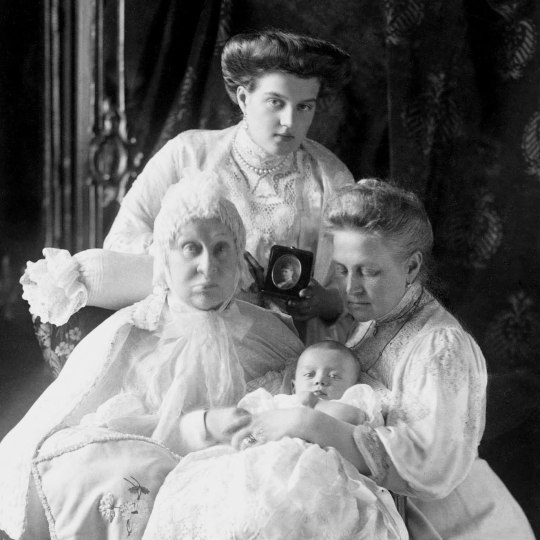

April 18, 1890 - Grand Duchess Maria Pavlovna was born in St. Petersburg as the daughter of Grand Duke Paul Alexandrovich and Grand Duchess Alexandra Georgievna. This means she was a cousin of Tsar Nicholas II and Prince Philip, the Duke of Edinburgh. She was named after her late grandmother, Empress Maria Alexandrovna, and her aunt, grandaunt, and godmother, Empress Maria Feodorovna.
Maria was not yet two years old when her mother died from complications after giving birth to Maria's younger brother, Grand Duke Dmitri Pavlovich. Grand Duke Paul was so distraught by the unexpected death of his wife that he neglected his two small children, who were left in the care of his elder brother, Grand Duke Sergei Alexandrovich. Growing up without a mother and a frequently absent father, Maria and her brother Dimitri became very close, relying on each other for affection and companionship.
Shortly after Easter 1907, Prince Wilhelm, Duke of Södermanland, visited St. Petersburg and was introduced to the 16-year-old Maria Pavlovna. The prince was tall, thin, dark, and distinguished-looking "with beautiful grey eyes," Maria recalled in her memoirs. He stayed for dinner, and the following day, Maria was told that he wished to marry her. The official betrothal was announced in June 1907 at Peterhof Palace.
Maria Pavlovna later wrote that she felt her aunt had rushed her into the marriage. In her memoirs, Maria wrote: "I was using Wilhelm, in a sense, only to obtain my freedom." She and Prince Wilhelm married the following year in Tsarskoye Selo, and she became Princess Maria, the Duchess of Södermanland. The couple had one child together in 1909, Prince Lennart (later Lennart Bernadotte).
Their marriage was not happy, and they dissolved in March 1914. Maria returned to her home country in the same year as the divorce. After the revolution, she fled to France, and towards the end of her life, she lived in Konstanz, West Germany, near her son Lennart and his family.
Photo 1: Prince Wilhelm and Grand Duchess Maria Pavlovna photographed on their wedding day in 1908.
Photo 2: Grand Duke Sergei Alexandrovich and Grand Duchess Elizabeth Feodorovna photographed with Grand Duke Paul Alexandrovich and his children Dmitri and Maria in 1892. Portrait taken from Wikimedia Commons.
Photo 3: Photograph of Grand Duchess Alexandra Iosifovna, her daughter Queen Olga of the Hellenes, her great-granddaughter Princess Maria and her great-great-grandson Prince Lennart of Sweden. Princess Maria is holding a photograph of her mother, Grand Duchess Alexandra Georgievna. The photograph was taken in 1909.
Photo 4: Prince Wilhelm and Princess Maria were photographed together in 1908 at their home, Stenhammar Castle. Maria is pictured wearing the Sweden dress. Portrait taken from Wikimedia Commons.
#swedish royal family#russian imperial family#royal history#grand duchess maria pavlovna#princess maria#prince wilhelm#prince wilhelm of sweden#prince lennart#lennart bernadotte#on this day#today in history#swedish history#russian history#my upload
9 notes
·
View notes
Text

"My parents frequently visited Rumpenheim, and I was sometimes allowed to accompany them. I used then to play with the pretty daughters of Prince Christian. The elder, Alexandra, the future consort of King Edward VII, of England, was a beautiful slim girl. She retained her wonderful waist and her light airy, swinging gait to an advanced age. Later on, when I had the honour of meeting her, she teased me with having cuffed and even scratched her when we played tops, hoops and “ rooms to let.” Truthfulness compelled me to reply that I also had the honour of having been treated somewhat ungently now and again by the delightful Princess herself. The Princess Dagmar, who later became Maria Feodorovna, Empress of Russia, was more spirited and also more intelligent than her sister Alexandra (who was, three years older) but self-willed".
Prince von Bulow "Memories 1849 - 1897"
5 notes
·
View notes
Text


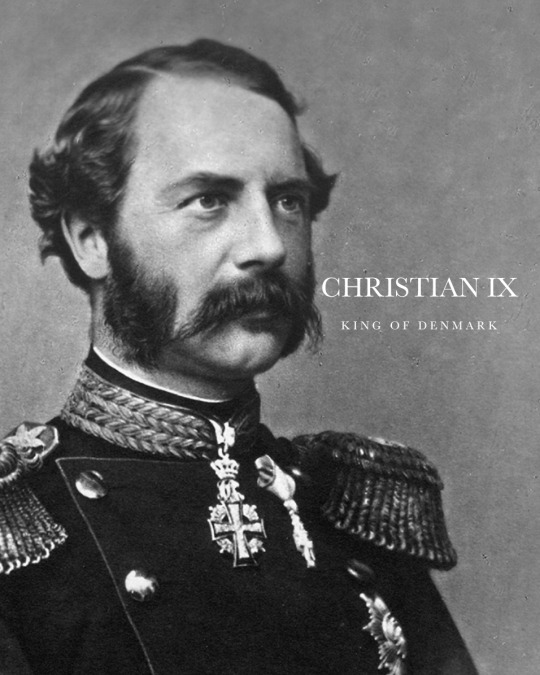


GODPARENTS OF GRAND DUCHESS XENIA ALEXANDROVNA
Grand Duchess Xenia Alexandrovna of Russia was born during the reign of her grandfather Emperor Alexander II on 6 April 1875 at the Anichkov Palace, Saint Petersburg. She was the elder daughter of the Tsesarevich (later Alexander III) and his wife, Tsesarevna Maria Feodorovna of Russia (later Empress consort). She was christened 29 April in Saint Petersburg, with her godparents listed below:
PRINCESS MARIE OF HESSE AND BY RHINE, EMPRESS MARIA ALEXANDROVNA OF RUSSIA - her paternal grandmother, the consort of Emperor Alexander II, was one of her godparents. Known for her intellect, she was one of the founders of the Russian Red Cross Society. However, she suffered from tuberculosis from 1863 and spent long stays in southern Europe to avoid harsh winters. Maria passed away from illness when Xenia was still a child.
KING CHRISTIAN IX OF DENMARK - her maternal grandfather, the Danish King was one of her godparents. His initial unpopularity at the start of his reign, and the many years of political strife, where the king was in conflict with large parts of the population, his popularity recovered towards the end of his reign, and he became a national icon due to the length of his reign.
GRAND DUKE VLADIMIR ALEXANDROVICH - her formidable uncle was another of her godparents. He followed a military career and occupied important military positions during the reigns of the last three Russian Emperors, including her father Alexander III and brother Nicholas II.
PRINCESS THYRA OF DENMARK, CROWN PRINCESS OF HANOVER AND DUCHESS OF CUMEBRLAND - her maternal aunt and look-alike, was among the grand duchess' godparents. The youngest daughter and fifth child of Christian IX of Denmark. In 1878, she married Ernest Augustus, the exiled heir to the Kingdom of Hanover. As the Kingdom of Hanover had been annexed by Prussia in 1866, she spent most of her life in exile with her husband in Austria.
Source
22 notes
·
View notes
Text

Empress Maria Feodorovna and Grand Duchess Xenia Alexandrovna of Russia, 1891
—
Maria Feodorovna (Mariya Fyodorovna; 26 November 1847 – 13 October 1928), known before her marriage as Princess Dagmar of Denmark, was Empress of Russia from 1881 to 1894 as the wife of Emperor Alexander III.
She was the second daughter of Christian IX of Denmark and Louise of Hesse-Kassel.
Maria's eldest son became the last Russian monarch, Emperor Nicholas II.
Maria lived for 10 years after Bolshevik functionaries murdered Nicholas and his immediate family in 1918.
Grand Duchess Xenia Alexandrovna of Russia (6 April [O.S. 25 March] 1875 – 20 April 1960) was the elder daughter and fourth child of Tsar Alexander III of Russia and Empress Maria Feodorovna of Russia (née Princess Dagmar of Denmark) and the sister of Emperor Nicholas II.
#Empress Maria Feodorovna of Russia#Princess Dagmar of Denmark#Grand Duchess Xenia Alexandrovna of Russia#House of Glücksburg#House of Hesse#House of Romanov-Holstein-Gottorp
4 notes
·
View notes
Text
The Romanovs and the Zodiac
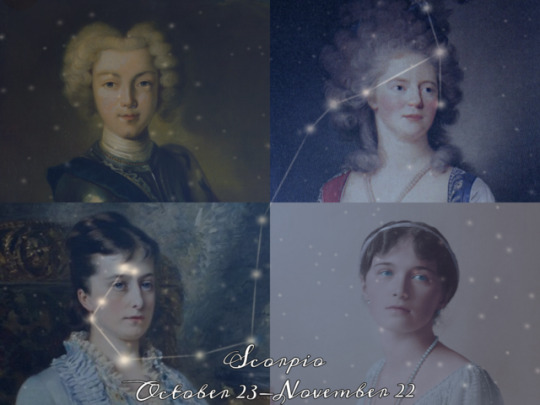
Scorpio
The eighth sign in the Zodiac, Scorpio is a water sign and a fixed negative sign. Scorpio used to be thought to be ruled by the planet Mars, but after the discovery of the planet Pluto in 1930, it became associated with Scorpio instead. Scorpio is associated with three animals; the snake, the eagle (the Phoenix) and most famously the scorpion. The snake and eagle are related to the nearby constellations of Ophiuchus and Aquila. Scorpio is also associated with the Greek deity Artemis, who is said to have created the constellation Scorpius. Scorpio's colours are deep red, maroon, brown, and black. Famous Romanovs born under the Scorpio include; Emperor Peter II (b. October 23, 1715), Empress Maria Feodorovna the Elder (b. October 25, 1759), Princess Catherine Yurievskaya (b. November 14, 1847), and Grand Duchess Olga Nikolaevna (b. November 15, 1895).
#peter ii#empress maria feodorovna the elder#princess catherine dolgorukova#princess catherine yurievskaya#grand duchess olga nikolaevna#olga nikolaevna#scorpio#the romanovs and the zodiac#house of romanov#imperial russia#russian history#russian empire#my edit
16 notes
·
View notes
Photo

Gathering of royal families at Coburg for the wedding festivies of Ernest Louis and Victoria Melita [supersized].
#romanov#british royal family#prussian imperial family#queen victoria#nicholas ii#alexandra feodorovn#maria pavlovna the elder#elizaveta feodorovna#maria alexandrovna#edward vii#wilhelm ii#irene of hesse#victoria of hesse#empress frederick#sergei alexandrovich#and other#my collection
73 notes
·
View notes
Text
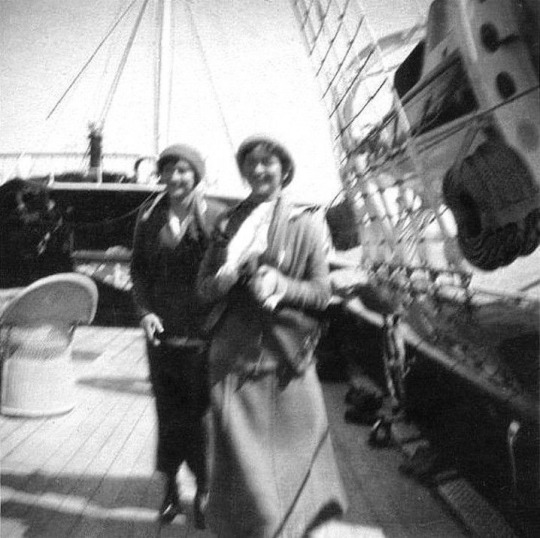


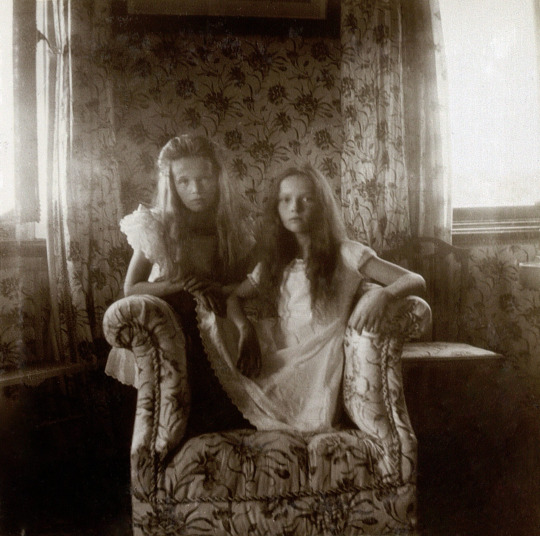
Happy Birthday Tatiana!
Grand Duchess Tatiana Nikolaevna, Olga’s younger sister, was born on June 10th, 1897 in Peterhof. She was the second child of the last Tsar of Russia, Nicholas II. He recorded in his diary: “The second bright happy day in our family: at 10:40 in the morning the Lord blessed us with a daughter - Tatiana. …Tatiana weighs 8 3/4 pounds and is 54 centimeters long. Our eldest is very funny with her.”
Growing up, Olga and Tatiana were known as the “big pair” to differentiate them from their two younger sisters, Maria and Anastasia, who were known as the “little pair.” The pairs would often be dressed in very similar clothing and shared a bedroom together in the Alexander Palace. While all of the sisters were very close to each other, especially as they matured, the pairs had more of a mutual understanding and trust with one another.
“[Olga’s] more careful sister, Tatiana, would suggest practical measures, would note names and details, and come back to the subject later out of a sense of duty. …[Tatiana] had a less strong character than Olga Nikolaevna, whose lead she would always follow, but she could make up her mind in an emergency quicker than her elder sister, and never lost her head. …[Tatiana] became much better known than her cleverer elder sister, as she took more trouble about the people she met.” -Baroness Sophie Buxhoeveden, lady-in-waiting to the girls’ mother, Empress Alexandra Feodorovna.
“Having friends was very important to [Tatiana], and like her sister Olga, she eagerly sought them out. …Unlike Olga, [Tatiana] never complained when asked to do a chore by her parents. …Imprisonment was tough on Tatiana. Like her older sister, she became even more thin and withdrawn. Tatiana was religious, much in the same way her mother was, and she was an inspiration to the rest of the family in captivity.”
Tatiana was a tremendous source of support for her family while they were in captivity. She assisted in taking care of her younger brother Alexei, who had suffered from a hemorrhage and was unable to walk, while they were left in Tobolsk without their parents. Tatiana and Olga were holding onto one another when they were killed on July 17th, 1918.
#history#russia#royalty#romanov#house of romanov#grand duchess olga nikolaevna#olga nikolaevna#grand duchess tatiana#tatiana nikolaevna#the big pair
80 notes
·
View notes
Text


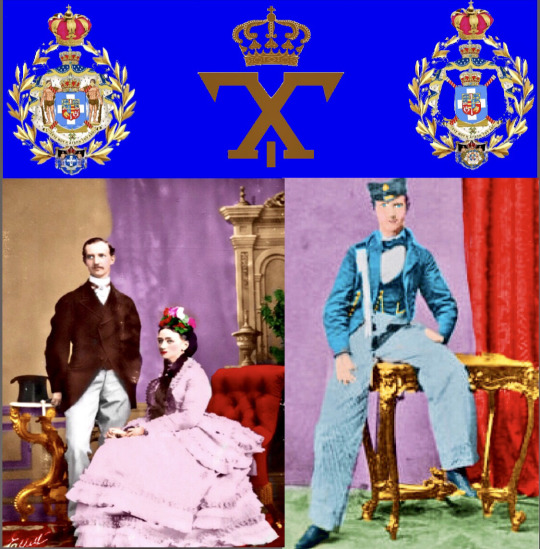
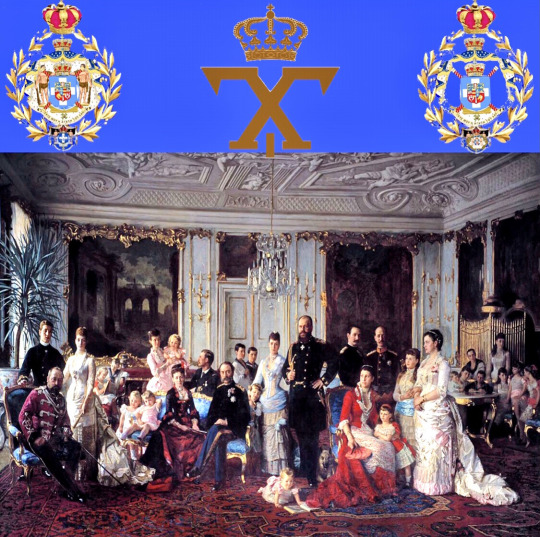
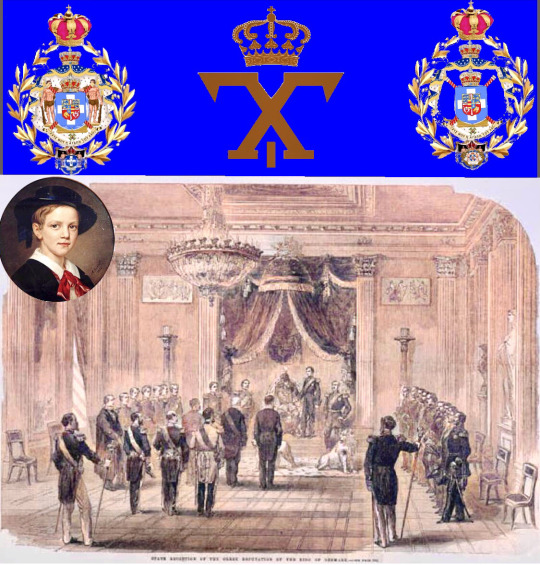


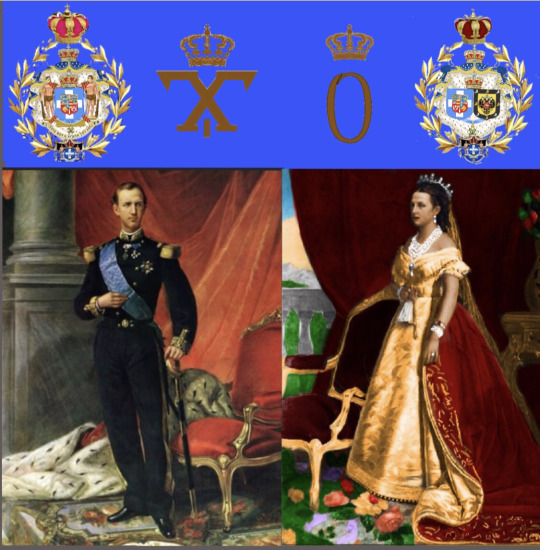
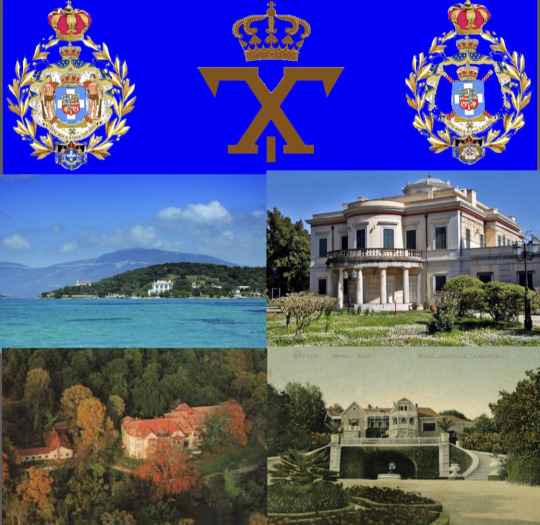
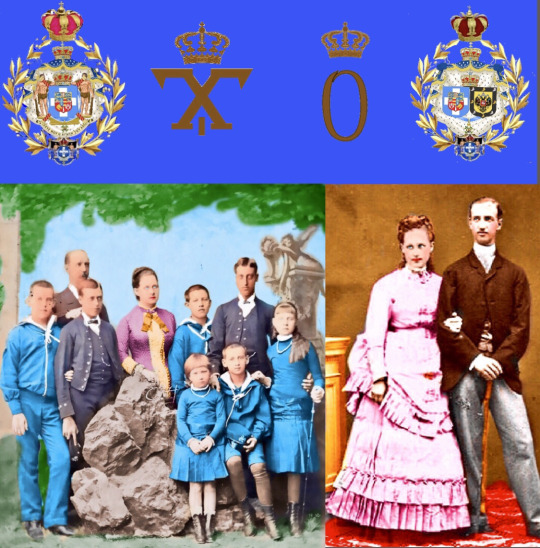
PART 1
George (24 December 1845 – 18 March 1913) was King of Hellenes (Greeks) from 30 March 1863 until his assassination in 1913.
Originally a Danish prince, he was born at the Yellow Palace, an 18th-century residence at 18 Amaliegade Street, right next to the Amalieenborg Palace complex in Copenhagen and seemed destined for a career in the Royal Danish Navy.
(1st Collage)
Although he was of royal blood (his mother and father were both great-grandchildren of Frederick V of Denmark and great-great-grandchildren of George II of Great Britain) his family was relatively obscure and lived a comparatively normal life by royal standards. In 1853, however, George's father was designated the heir presumptive to the childless Frederick VII of Denmark, and the family became princes and princesses of Denmark.
(2nd and 3rd collage)
George's siblings were Frederick (who succeeded their father as King of Denmark, and whose second son was elected as Haakon VII of Norway in 1905), Alexandra (who became wife of Edward VII of the United Kingdom and the mother of George V), Dagmar (who, as Empress Maria Feodorovna, was consort of Alexander III of Russia and the mother of Nicholas II), Thyra (who married Ernest Augustus, Crown Prince of Hanover) and Valdemar.
George's mother tongue was Danish, with English as a second language. He was also taught French and German.He embarked on a career in the Royal Danish Navy, and enrolled as a naval cadet along with his elder brother Frederick. While Frederick was described as "quiet and extremely well-behaved", George was "lively and full of pranks".
(4th Collage)
He was only 17 years old when he was elected king by the Greek National Assembly, which had deposed the unpopular Otto.
His nomination was both suggested and supported by the Great Powers: the United Kingdom of Great Britain and Ireland, the Second French Empire and the Russian Empire.
Following the overthrow of the Bavarian-born King Otto of Greece in October 1862,the Greek people had rejected Otto's brother and designated successor Luitpold, although they still favored a monarchy rather than a republic. Many Greeks, seeking closer ties to the pre-eminent world power, the United Kingdom, rallied around Prince Alfred, Duke of Edinburgh, second son of Queen Victoria and Prince Albert.British prime minister Lord Palmerston believed that the Greeks were "panting for increase in territory",hoping for a gift of the Ionian Islands, which were then a British protectorate. The London Conference of 1832, however, prohibited any of the Great Powers' ruling families from accepting the crown, and in any event, Queen Victoria was adamantly opposed to the idea. The Greeks nevertheless insisted on holding a plebiscite in which Prince Alfred received over 95% of the 240,000 votes.There were 93 votes for a Republic and six for a Greek.King Otto received one vote.
With Prince Alfred's exclusion, the search began for an alternative candidate. The French favored Henri d'Orléans, duc d'Aumale, while the British proposed Queen Victoria's brother-in-law Ernest II, Duke of Saxe-Coburg and Gotha, her nephew Prince Leiningen, and Archduke Maximilian of Austria, among others. Eventually, the Greeks and Great Powers winnowed their choice to Prince William of Denmark, who had received six votes in the plebiscite.Aged only 17, he was elected King of the Hellenes on 30 March 1863 by the Greek National Assembly under the regnal name of George I
(5 th and 6th Collage )
He married Grand Duchess Olga Constantinovna of Russia in 1867, and became the first monarch of a new Greek dynasty.
George first met Grand Duchess Olga Constantinovna of Russia in 1863, when she was 12 years old, on a visit to the court of Tsar Alexander II between his election to the Greek throne and his arrival in Athens. They met for a second time in April 1867, when George went to the Russian Empire to visit his sister Dagmar, who had married into the Russian imperial family. While George was privately a Lutheran, the Romanovs were Orthodox Christians like the majority of Greeks, and George thought a marriage with a Russian grand duchess would re-assure his subjects on the question of his future children's religion.Olga was just 16 years old when she married George at the Winter Palace in Saint Petersburg on 27 October 1867. After a honeymoon at Tsarskoye Selo, the couple left Russia for Greece on 9 November.
(7th and 8th Collage)
As a wedding gift, the Tsar gave George a group of islands in the Petalioi Gulf, which the family visited on the royal yacht Amphitrite.
(1st picture in 9th Collage)
George later purchased a country estate, Tatoi, north of Athens, and on Corfu he got from the people of Corfu as a gift for Ionian Islands transferred from British to Greek sovereignty a summer villa called Mon Repos former English High Commissioners summer residence.
(2nd picture in 9th Collage)
George developed Tatoi, building roads and planting grapes for making his own wine, Chateau Décélie
(3rd and 4th pictures in 9th Collage)
Over the next twenty years, they had eight children:
Constantine (1868–1923), who married Princess Sophia of Prussia;
George (1869–1957), who married Princess Marie Bonaparte;
Alexandra (1870–1891), who married Grand Duke Paul Alexandrovich of Russia;
Nicholas (1872–1938), who married Grand Duchess Elena Vladimirovna of Russia;
Maria (1876–1940), who married firstly Grand Duke George Mikhailovich of Russia and secondly Admiral Perikles Ioannidis;
Olga (1880), who died aged seven months;
Andrew (1882–1944), who married Princess Alice of Battenberg parents of Philip Duke of Edinburgh Prince consort of Queen Elizabeth II of the UK
Christopher (1888–1940), who married firstly American widow Nancy Stewart Worthington Leeds and secondly Princess Françoise of Orléans.
(10th Collage)
MΕΡΟΣ 1ο
176 χρόνια από τη γέννηση του Α.Μ. Γεωργίου Α΄ των Ελλήνων Πρίγκηπα της Δανίας
Ο Γεώργιος (24 Δεκεμβρίου 1845 – 18 Μαρτίου 1913) ήταν Βασιλιάς των Ελλήνων (Ελλήνων) από τις 30 Μαρτίου 1863 μέχρι τη δολοφονία του το 1913.
Αρχικά Δανός πρίγκιπας, γεννήθηκε στο Κίτρινο Παλάτι, μια κατοικία του 18ου αιώνα στην οδό Amaliegade 18, ακριβώς δίπλα στο συγκρότημα των παλατιών Amalieenborg στην Κοπεγχάγη και φαινόταν προορισμένος για μια καριέρα στο Βασιλικό Ναυτικό της Δανίας.
(1ο Κολάζ)
Αν και ήταν βασιλικού αίματος (η μητέρα και ο πατέρας του ήταν και τα δύο δισέγγονα του Φρειδερίκου Ε' της Δανίας και τρισέγγονα του Γεωργίου Β' της Μεγάλης Βρετανίας), η οικογένειά του δεν ήταν σχετικά επιφανης και ζούσε μια σχετικά φυσιολογική ζωή για τα βασιλικά πρότυπα. Το 1853, ωστόσο, ο πατέρας του Γεωργιου ορίστηκε ως ο κληρονόμος του άτεκνου Φρειδερίκου Ζ' της Δανίας και η οικογένεια έγινε πρίγκιπες και πριγκίπισσες της Δανίας.
(2ο και 3ο κολάζ)
ήταν σύζυγος του Αλέξανδρου Γ' της Ρωσίας και μητέρα του Νικολάου Β'), η Θύρα (που παντρεύτηκε τον Ερνέστο Αύγουστο, διάδοχο του Ανόβερου) και τον Βαλντεμάρ.
Η μητρική γλώσσα του Γιώργου ήταν τα δανικά, με δεύτερη γλώσσα τα αγγλικά. Διδάχτηκε επίσης γαλλικά και γερμανικά. Ξεκίνησε μια καριέρα στο Βασιλικό Ναυτικό της Δανίας και γράφτηκε ως ναυτικός δόκιμος μαζί με τον μεγαλύτερο αδελφό του Φρειδερίκη. Ενώ ο Φρειδερίκος χαρακτηρίστηκε ως «ήσυχος και εξαιρετικά καλοσυντηρημένος», ο Τζορτζ ήταν «ζωηρός και γεμάτος φάρσες».
Ήταν μόλις 17 ετών όταν εξελέγη βασιλιάς από την Ελληνική Εθνοσυνέλευση, η οποία είχε καθαιρέσει τον αντιδημοφιλή Όθωνα.
Η υποψηφιότητά του προτάθηκε και υποστηρίχθηκε από τις Μεγάλες Δυνάμεις: το Ηνωμένο Βασίλειο της Μεγάλης Βρετανίας και της Ιρλανδίας, τη Δεύτερη Γαλλική Αυτοκρατορία και τη Ρωσική Αυτοκρατορία.
Μετά την ανατροπή του γεννημένου στη Βαυαρία βασιλιά Όθωνα της Ελλάδας τον Οκτώβριο του 1862, ο ελληνικός λαός είχε απορρίψει τον αδελφό του Όθωνα και είχε ορίσει διάδοχο τον Λούιτπολντ, αν και εξακολουθούσε να ευνοεί μια μοναρχία και όχι μια δημοκρατία. Πολλοί Έλληνες, αναζητώντας στενότερους δεσμούς με την κατεξοχήν παγκόσμια δύναμη, το Ηνωμένο Βασίλειο, συσπειρώθηκαν γύρω από τον πρίγκιπα Άλφρεντ, δούκα του Εδιμβούργου, δεύτερο γιο της βασίλισσας Βικτώριας και του πρίγκιπα Αλβέρτου. Ο Βρετανός πρωθυπουργός Λόρδος Πάλμερστον πίστευε ότι οι Έλληνες «λαχανιάζουν για αύξηση σε επικράτεια», ελπίζοντας σε δώρο των Ιονίων Νήσων, που τότε ήταν βρετανικό προτεκτοράτο. Η Διάσκεψη του Λονδίνου του 1832, ωστόσο, απαγόρευσε σε οποιαδήποτε από τις κυρίαρχες οικογένειες των Μεγάλων Δυνάμεων να αποδεχθεί το στέμμα, και σε κάθε περίπτωση, η βασίλισσα Βικτώρια ήταν κατηγορηματικά αντίθετη στην ιδέα. Οι Έλληνες, ωστόσο, επέμειναν στη διεξαγωγή δημοψηφίσματος στο οποίο ο πρίγκιπας Άλφρεντ έλαβε πάνω από το 95% των 240.000 ψήφων. Υπήρχαν 93 ψήφοι για μια Δημοκρατία και έξι για έναν Έλληνα. Ο βασιλιάς Όθωνας έλαβε μία ψήφο.
Με τον αποκλεισμό του πρίγκιπα Άλφρεντ ξεκίνησε η αναζήτηση εναλλακτικού υποψηφίου. Οι Γάλλοι ευνόησαν τον Henri d'Orléans, duc d'Aumale, ενώ οι Βρετανοί πρότειναν μεταξύ άλλων τον κουνιάδο της Βασίλισσας Βικτωρίας, Ερνέστο Β', δούκα του Saxe-Coburg και Gotha, τον ανιψιό της πρίγκιπα Leiningen και τον αρχιδούκα Maximilian της Αυστρίας. Τελικά, οι Έλληνες και οι Μεγάλες Δυνάμεις κέρδισαν την επιλογή τους στον πρίγκιπα Γουλιέλμο της Δανίας, ο οποίος είχε λάβει έξι ψήφους στο δημοψήφισμα. Σε ηλικία μόλις 17 ετών, εξελέγη Βασιλιάς των Ελλήνων στις 30 Μαρτίου 1863 από την Ελληνική Εθνοσυνέλευση με το βασιλικό όνομα Γεώργιος Ι
Παντρεύτηκε τη Μεγάλη Δούκισσα Όλγα Κωνσταντίνοβνα της Ρωσίας το 1867 και έγινε ο πρώτος μονάρχης μιας νέας ελληνικής δυναστείας.
Ο Γεώργιος συνάντησε για πρώτη φορά τη Μεγάλη Δούκισσα Όλγα Κωνσταντίνοβνα της Ρωσίας το 1863, όταν ήταν 12 ετών, σε μια επίσκεψη στην αυλή του Τσάρου Αλέξανδρου Β' μεταξύ της εκλογής του στον ελληνικό θρόνο και της άφιξής του στην Αθήνα. Συναντήθηκαν για δεύτερη φορά τον Απρίλιο του 1867, όταν ο Γεώργιος πήγε στη Ρωσική Αυτοκρατορία για να επισκεφτεί την αδελφή του Ντάγκμαρ, η οποία είχε παντρευτεί τη ρωσική αυτοκρατορική οικογένεια. Ενώ ο Τζορτζ ήταν ιδιωτικά Λουθηρανός, οι Ρομανόφ ήταν Ορθόδοξοι Χριστιανοί όπως η πλειονότητα των Ελλήνων, και ο Τζορτζ πίστευε ότι ένας γάμος με μια Ρωσίδα μεγάλη δούκισσα θα επαναβεβαίωνε τους υπηκόους του για το ζήτημα της μελλοντικής θρησκείας των παιδιών του. Η Όλγα ήταν μόλις 16 ετών όταν παντρεύτηκε τον Γιώργο στα Χειμερινά Ανάκτορα στην Αγία Πετρούπολη στις 27 Οκτωβρίου 1867. Μετά από ένα μήνα του μέλιτος στο Tsarskoye Selo, το ζευγάρι έφυγε από τη Ρωσία για την Ελλάδα στις 9 Νοεμβρίου.
Ως γαμήλιο δώρο, ο Τσάρος έδωσε στον Γιώργο ένα συγκρότημα νησιών στον κόλπο των Πεταλιών, το οποίο επισκέφτηκε η οικογένεια με το βασιλικό γιοτ Αμφιτρίτη. Ο Γιώργος αργότερα αγόρασε ένα εξοχικό κτήμα, το Τατόι, βόρεια της Αθήνας, και στην Κέρκυρα πήρε από τους Κερκυραίους ως δώρο για τα Επτάνησα, μεταβίβασε από την αγγλική στην ελληνική κυριαρχία μια θερινή βίλα που ονομαζόταν Mon Repos πρώην θερινή κατοικία των Άγγλων Ύπατων Αρμοστειών.
Ο Γιώργος ανέπτυξε το Τατόι, χτίζοντας δρόμους και φυτεύοντας σταφύλια για να φτιάξει το δικό του κρασί, Chateau Décélie
Τα επόμενα είκοσι χρόνια απέκτησαν οκτώ παιδιά:
Κωνσταντίνος (1868–1923), που παντρεύτηκε την πριγκίπισσα Σοφία της Πρωσίας.
George (1869–1957), που παντρεύτηκε την πριγκίπισσα Μαρία Βοναπάρτη.
Αλεξάνδρα (1870–1891), που παντρεύτηκε τον Μέγα Δούκα Παύλο Αλεξάντροβιτς της Ρωσίας.
Νικόλαος (1872–1938), ο οποίος παντρεύτηκε τη Μεγάλη Δούκισσα Έλενα Βλαντιμίροβνα της Ρωσίας.
Μαρία (1876–1940), που παντρεύτηκε πρώτον τον Μέγα Δούκα Γεώργιο Μιχαήλοβιτς της Ρωσίας και δεύτερον τον ναύαρχο Περικλή Ιωαννίδη.
Όλγα (1880), που πέθανε σε ηλικία επτά μηνών.
Andrew (1882–1944), ο οποίος παντρεύτηκε την πριγκίπισσα Αλίκη του Battenberg, γονείς του Φίλιππου Δούκα του Εδιμβούργου, πρίγκιπα συζύγου της βασίλισσας Ελισάβετ Β του Ηνωμένου Βασιλείου
Christopher (1888–1940), ο οποίος παντρεύτηκε πρώτα την Αμερικανίδα χήρα Nancy Stewart Worthington Leeds και δεύτερον την πριγκίπισσα Françoise της Ορλεάνης.
Η βασιλεία του Γεωργίου σχεδόν 50 ετών (η μεγαλύτερη στη σύγχρονη ελληνική ιστορία) χαρακτηρίστηκε από εδαφικά κέρδη καθώς η Ελλάδα εδραίωσε τη θέση της στην Ευρώπη πριν από τον Α' Παγκόσμιο Πόλεμο. Η Βρετανία παραχώρησε ειρηνικά τα Επτάνησα το 1864, ενώ η Θεσσαλία προσαρτήθηκε από την Οθωμανική Αυτοκρατορία μετά τον Ρωσοτουρκικό πόλεμο (1877–1878). Η Ελλάδα δεν ήταν πάντα επιτυχημένη στις εδαφικές της φιλοδοξίες. ηττήθηκε στον ελληνοτουρκικό πόλεμο (1897). Κατά τον Α' Βαλκανικό Πόλεμο, αφού τα ελληνικά στρατεύματα είχαν καταλάβει μεγάλο μέρος της ελληνικής Μακεδονίας, ο Γεώργιος δολοφονήθηκε στη Θεσσαλονίκη. Σε σύγκριση με τη δική του μακρά θητεία, η βασιλεία των διαδόχων του Κωνσταντίνου Α', Αλεξάνδρου και Γεωργίου Β' αποδείχθηκε σύντομη και ανασφαλής.
Εκτός από τα Επτάνησα, η επέκταση του ελληνικού βασιλείου από το 1863 έως το 1947. Η Θεσσαλία μεταφέρθηκε από την Οθωμανική στην Ελληνική κυριαρχία το 1881 και τα Δώδεκα Νησιά του Αιγαίου μεταφέρθηκαν από τους Ιταλούς στην Ελλάδα κατά τη διάρκεια της βασιλείας του βασιλιά Παύλου Α' των Ελλήνων εγγονός στον βασιλιά Γεώργιο Α' .
Καθώς πλησίαζε την πεντηκοστή επέτειο από την άνοδό του, ο Βασιλιάς έκανε σχέδια να παραιτηθεί υπέρ του γιου του Κωνσταντίνου αμέσως μετά τον εορτασμό της χρυσής ιωβηλείας του τον Οκτώβριο του 1913. Όπως έκανε στην Αθήνα, ο Γεώργιος περιηγήθηκε τη Θεσσαλονίκη χωρίς καμία ουσιαστική δύναμη προστασίας . Ενώ βρισκόταν σε μια απογευματινή βόλτα κοντά στον Λευκό Πύργο στις 18 Μαρτίου 1913, πυροβολήθηκε από κοντά στην πλάτη από τον Αλέξανδρο Σχινά, ο οποίος «έλεγε ότι ανήκε σε σοσιαλιστική οργάνωση» και «όταν συνελήφθη δήλωσε ότι είχε σκοτώσει τον βασιλιά. γιατί αρνήθηκε να του δώσει χρήματα». Ο Γιώργος πέθανε ακαριαία, με τη σφαίρα να έχει εισχωρήσει στην καρδιά του. Η ελληνική κυβέρνηση αρνήθηκε οποιοδήποτε πολιτικό κίνητρο για τη δολοφονία, λέγοντας ότι ο Σχινάς ήταν αλκοολικός αλήτης. Ο Σχινάς βασανίστηκε στη φυλακή και έπεσε μέχρι θανάτου από το παράθυρο του αστυνομικού τμήματος έξι εβδομάδες αργότερα.
Η σορός του βασιλιά μεταφέρθηκε στην Αθήνα στην Αμφιτρίτη, συνοδεία στολίσκου πλοίων του πολεμικού ναυτικού. Για τρεις ημέρες το φέρετρο του Βασιλιά, ντυμένο με τη δανική και την ελληνική σημαία, βρισκόταν στον Μητροπολιτικό Καθεδρικό Ναό της Αθήνας πριν το σώμα του παραδοθεί σε τάφος στο παλάτι του στο Τατόι.
Τα αδέρφια του Γεωργίου ήταν ο Φρειδερίκος (ο οποίος διαδέχτηκε τον πατέρα τους ως βασιλιάς της Δανίας και του οποίου ο δεύτερος γιος εξελέγη ως Haakon VII της Νορβηγίας το 1905), η Αλεξάνδρα (η οποία έγινε σύζυγος του Εδουάρδου Ζ' του Ηνωμένου Βασιλείου και μητέρα του Γεωργίου Ε'), η Ντάγκμαρ (η οποία, ως αυτοκράτειρα Μαρία Φεοντόροβνα, ήταν σύζυγος του Αλέξανδρου Γ' της Ρωσίας και μητέρα του Νικολάου Β'), η Θύρα (που παντρεύτηκε τον Ερνέστο Αύγουστο, διάδοχο του Ανόβερου) και τον Βαλντεμάρ
Η μητρική γλώσσα του Γιώργου ήταν τα δανικά, με δεύτερη γλώσσα τα αγγλικά. Διδάχτηκε επίσης γαλλικά και γερμανικά. Ξεκίνησε μια καριέρα στο Βασιλικό Ναυτικό της Δανίας και γράφτηκε ως ναυτικός δόκιμος μαζί με τον μεγαλύτερο αδελφό του Φρειδερίκο. Ενώ ο Φρειδερίκος χαρακτηρίστηκε ως «ήσυχος και εξαιρετικά καλοσυντηρημένος», ο Γεωργιος ήταν «ζωηρός και γεμάτος φάρσες».
(4ο Κολάζ)
Ήταν μόλις 17 ετών όταν εξελέγη βασιλιάς από την Ελληνική Εθνοσυνέλευση, η οποία είχε καθαιρέσει τον αντιδημοφιλή Όθωνα.
Η υποψηφιότητά του προτάθηκε και υποστηρίχθηκε από τις Μεγάλες Δυνάμεις: το Ηνωμένο Βασίλειο της Μεγάλης Βρετανίας και της Ιρλανδίας, τη Δεύτερη Γαλλική Αυτοκρατορία και τη Ρωσική Αυτοκρατορία.
Μετά την ανατροπή του γεννημένου στη Βαυαρία βασιλιά Όθωνα της Ελλάδας τον Οκτώβριο του 1862, ο ελληνικός λαός είχε απορρίψει τον αδελφό του Όθωνα και είχε ορίσει διάδοχο τον Λούιτπολντ, αν και εξακολουθούσε να ευνοεί μια μοναρχία και όχι μια δημοκρατία. Πολλοί Έλληνες, αναζητώντας στενότερους δεσμούς με την κατεξοχήν παγκόσμια δύναμη, το Ηνωμένο Βασίλειο, συσπειρώθηκαν γύρω από τον πρίγκιπα Άλφρεντ, δούκα του Εδιμβούργου, δεύτερο γιο της βασίλισσας Βικτώριας και του πρίγκιπα Αλβέρτου. Ο Βρετανός πρωθυπουργός Λόρδος Πάλμερστον πίστευε ότι οι Έλληνες «λαχανιάζουν για αύξηση σε επικράτεια», ελπίζοντας σε δώρο των Ιονίων Νήσων, που τότε ήταν βρετανικό προτεκτοράτο. Η Διάσκεψη του Λονδίνου του 1832, ωστόσο, απαγόρευσε σε οποιαδήποτε από τις κυρίαρχες οικογένειες των Μεγάλων Δυνάμεων να αποδεχθεί το στέμμα, και σε κάθε περίπτωση, η βασίλισσα Βικτώρια ήταν κατηγορηματικά αντίθετη στην ιδέα. Οι Έλληνες, ωστόσο, επέμειναν στη διεξαγωγή δημοψηφίσματος στο οποίο ο πρίγκιπας Άλφρεντ έλαβε πάνω από το 95% των 240.000 ψήφων. Υπήρχαν 93 ψήφοι για μη Βασιλευομένη Δημοκρατία και έξι για έναν Έλληνα. Ο βασιλιάς Όθωνας έλαβε μία ψήφο.
Με τον αποκλεισμό του πρίγκιπα Άλφρεντ ξεκίνησε η αναζήτηση εναλλακτικού υποψηφίου. Οι Γάλλοι ευνόησαν τον Henri d'Orléans, duc d'Aumale, ενώ οι Βρετανοί πρότειναν μεταξύ άλλων τον κουνιάδο της Βασίλισσας Βικτωρίας, Ερνέστο Β', δούκα του Saxe-Coburg και Gotha, τον ανιψιό της πρίγκιπα Leiningen και τον αρχιδούκα Μαξιμιλιανο της Αυστρίας. Τελικά, οι Έλληνες και οι Μεγάλες Δυνάμεις κέρδισαν την επιλογή τους στον πρίγκιπα Γουλιέλμο της Δανίας, ο οποίος είχε λάβει έξι ψήφους στο δημοψήφισμα. Σε ηλικία μόλις 17 ετών, εξελέγη Βασιλιάς των Ελλήνων στις 30 Μαρτίου 1863 από την Ελληνική Εθνοσυνέλευση με το βασιλικό όνομα Γεώργιος Ι
(5ο και 6ο Κολάζ)
Παντρεύτηκε τη Μεγάλη Δούκισσα Όλγα Κωνσταντίνοβνα της Ρωσίας το 1867 και έγινε ο πρώτος μονάρχης μιας νέας ελληνικής δυναστείας.
Ο Γεώργιος συνάντησε για πρώτη φορά τη Μεγάλη Δούκισσα Όλγα Κωνσταντίνοβνα της Ρωσίας το 1863, όταν ήταν 12 ετών, σε μια επίσκεψη στην αυλή του Τσάρου Αλέξανδρου Β' μεταξύ της εκλογής του στον ελληνικό θρόνο και της άφιξής του στην Αθήνα. Συναντήθηκαν για δεύτερη φορά τον Απρίλιο του 1867, όταν ο Γεώργιος πήγε στη Ρωσική Αυτοκρατορία για να επισκεφτεί την αδελφή του Ντάγκμαρ, η οποία είχε παντρευτεί στη ρωσική αυτοκρατορική οικογένεια. Ενώ ο Γεωργιος ήταν ιδιωτικά Λουθηρανός, οι Ρομανόφ ήταν Ορθόδοξοι Χριστιανοί όπως η πλειονότητα των Ελλήνων, και ο Γεωργιος πίστευε ότι ένας γάμος με μια Ρωσίδα μεγάλη δούκισσα θα επαναβεβαίωνε τους υπηκόους του για το ζήτημα της μελλοντικής θρησκείας των παιδιών του. Η Όλγα ήταν μόλις 16 ετών όταν παντρεύτηκε τον Γιώργο στα Χειμερινά Ανάκτορα στην Αγία Πετρούπολη στις 27 Οκτωβρίου 1867. Μετά από ένα μήνα του μέλιτος στο Tsarskoye Selo, το ζευγάρι έφυγε από τη Ρωσία για την Ελλάδα στις 9 Νοεμβρίου.
(7ο και 8ο κολάζ)
Ως γαμήλιο δώρο, ο Τσάρος έδωσε στον Γιώργο ένα συγκρότημα νησιών στον κόλπο των Πεταλιών, το οποίο επισκέφτηκε η οικογένεια με το βασιλικό γιοτ Αμφιτρίτη.
(1η εικόνα στο 9ο Κολάζ)
Ο Γιώργος αργότερα αγόρασε ένα εξοχικό κτήμα, το Τατόι, βόρεια της Αθήνας, και στην Κέρκυρα πήρε από τους Κερκυραίους ως δώρο για τα Επτάνησα, μεταβίβασε από την αγγλική στην ελληνική κυριαρχία μια θερινή βίλα που ονομαζόταν Mon Repos πρώην θερινή κατοικία των Άγγλων Ύπατων Αρμοστειών.
(2η εικόνα στο 9ο Κολάζ)
Ο Γιώργος ανέπτυξε το Τατόι, χτίζοντας δρόμους και φυτεύοντας σταφύλια για να φτιάξει το δικό του κρασί, Chateau Décélie
(3η και 4η εικόνα στο 9ο κολάζ)
Τα επόμενα είκοσι χρόνια απέκτησαν οκτώ παιδιά:
1)Κωνσταντίνος (1868–1923), που παντρεύτηκε την πριγκίπισσα Σοφία της Πρωσίας.
2)Γεώργιος (1869–1957), που παντρεύτηκε την πριγκίπισσα Μαρία Βοναπάρτη.
3)Αλεξάνδρα (1870–1891), που παντρεύτηκε τον Μέγα Δούκα Παύλο Αλεξάντροβιτς της Ρωσίας.
4)Νικόλαος (1872–1938), ο οποίος παντρεύτηκε τη Μεγάλη Δούκισσα Έλενα Βλαντιμίροβνα της Ρωσίας.
5)Μαρία (1876–1940), που παντρεύτηκε πρώτον τον Μέγα Δούκα Γεώργιο Μιχαήλοβιτς της Ρωσίας και δεύτερον τον ναύαρχο Περικλή Ιωαννίδη.
6)Όλγα (1880), που πέθανε σε ηλικία επτά μηνών.
7) Ανδρέας (1882–1944), ο οποίος παντρεύτηκε την πριγκίπισσα Αλίκη του Battenberg, γονείς του Φίλιππου Δούκα του Εδιμβούργου, πρίγκιπα συζύγου της βασίλισσας Ελισάβετ Β του Ηνωμένου Βασιλείου
8) (1888–1940), ο οποίος παντρεύτηκε πρώτα την Αμερικανίδα χήρα Nancy Stewart Worthington Leeds και δεύτερον την πριγκίπισσα Φρανγκισκη της Ορλεάνης.
(10ο και 11ο κολάζ)
Η βασιλεία του Γεωργίου σχεδόν 50 ετών (η μεγαλύτερη στη σύγχρονη ελληνική ιστορία) χαρακτηρίστηκε από εδαφικά κέρδη καθώς η Ελλάδα εδραίωσε τη θέση της στην Ευρώπη πριν από τον Α' Παγκόσμιο Πόλεμο. Η Βρετανία παραχώρησε ειρηνικά τα Επτάνησα το 1864, ενώ η Θεσσαλία προσαρτήθηκε από την Οθωμανική Αυτοκρατορία μετά τον Ρωσοτουρκικό πόλεμο (1877–1878). Η Ελλάδα δεν ήταν πάντα επιτυχημένη στις εδαφικές της φιλοδοξίες. ηττήθηκε στον ελληνοτουρκικό πόλεμο (1897). Κατά τον Α' Βαλκανικό Πόλεμο, αφού τα ελληνικά στρατεύματα είχαν καταλάβει μεγάλο μέρος της ελληνικής Μακεδονίας.
(12ο Κολάζ)
Σε σύγκριση με τη δική του μακρά θητεία, η βασιλεία των διαδόχων του Κωνσταντίνου Α', Αλεξάνδρου και Γεωργίου Β' αποδείχθηκε σύντομη και ανασφαλής.
Εκτός από τα Επτάνησα, η επέκταση του ελληνικού βασιλείου από το 1863 έως το 1947. Η Θεσσαλία μεταφέρθηκε από την Οθωμανική στην Ελληνική κυριαρχία το 1881 και τα Δώδεκα Νησιά του Αιγαίου μεταφέρθηκαν από τους Ιταλούς στην Ελλάδα κατά τη διάρκεια της βασιλείας του βασιλιά Παύλου Α' των Ελλήνων εγγονός στον βασιλιά Γεώργιο Α' .
(13ο Κολάζ)
Καθώς πλησίαζε την πεντηκοστή επέτειο από την άνοδό του, ο Βασιλιάς έκανε σχέδια να παραιτηθεί υπέρ του γιου του Κωνσταντίνου αμέσως μετά τον εορτασμό της χρυσής ιωβηλείας του τον Οκτώβριο του 1913. Όπως έκανε στην Αθήνα, ο Γεώργιος περιηγήθηκε τη Θεσσαλονίκη χωρίς καμία ουσιαστική δύναμη προστασίας . Ενώ ήταν σε μια απογευματινή βόλτα κοντά στον Λευκό Πύργο στις 18 Μαρτίου 1913, πυροβολήθηκε από κοντά στην πλάτη.
(14ο,15ο Κολάζ)
Ο δολοφόνος Αλέξανδρος Σχινάς, που «έλεγαν ότι ανήκε σε σοσιαλιστική οργάνωση» και «όταν συνελήφθη δήλωσε ότι σκότωσε τον Βασιλιά επειδή αρνήθηκε να του δώσει χρήματα».
Ο Γιώργος πέθανε ακαριαία, με τη σφαίρα να έχει εισχωρήσει στην καρδιά του. Η ελληνική κυβέρνηση αρνήθηκε οποιοδήποτε πολιτικό κίνητρο για τη δολοφονία, λέγοντας ότι ο Σχινάς ήταν αλκοολικός αλήτης. Ο Σχινάς βασανίστηκε στη φυλακή και έπεσε μέχρι θανάτου από το παράθυρο του αστυνομικού τμήματος έξι εβδομάδες αργότερα.
(16ο και 17ο κολάζ)
Η σορός του Βασιλιά μεταφέρθηκε στην Αθήνα με την Βασιλική Θαλαμηγό Αμφιτρίτη, συνοδεία στολίσκου πλοίων του λιμενικού.
(18ο Κολάζ)
Επί τρεις ημέρες το φέρετρο του Βασιλιά, ντυμένο με τη δανική και την ελληνική σημαία, βρισκόταν στον Μητροπολιτικό Καθεδρικό Ναό της Αθήνας προτού το σώμα του παραδοθεί σε τάφο στο παλάτι του στο Τατόι.
(19ο και 20ο κολάζ)
#kingconstantine#danishroyalfamily#crownprincepavlos#queenannemarie#greek royal family#house of romanov#greekroyals#crownprincessmariechantal#danishroyals#princeconstantinealexios#princessmarieolympia#princess theodora#princeachileasandreas#princenikolaos#princesstatiana#princesseirini#princessnina#princeodyseaskimon#princearistidesstavros#princefilippos
12 notes
·
View notes
Text

Empress Alexandra Feodorovna of Russia, consort of Emperor Nicholas I, with her eldest daughter, Grand Duchess Maria Nikolaevna, by Sokolov.
#empress alexandra feodorovna#grand duchess maria nikolaevna the elder#romanov#russia#sokolov#portrait painting
112 notes
·
View notes
Text

Emperor Nicholas I (1796 - 1855) and Empress Alexandra Feodorovna (1798 -1860 - nee Princess Friederike Luise Charlotte Wilhelmine of Prussia
Nicholas I, the Iron Tzar, and his sons
This couple was the first “Nicholas and Alexandra” in the Romanov Dynasty. They were Nicholas II's great grant-parents.
It was said that he was the best-looking man in Europe. She was tall and fair and enjoyed jewels, gowns, and balls. They loved each other, and their union was not unhappy, but he did not remain faithful to her (after he died, his last mistress was employed as Alexandra’s lectrice, and they became friends.) Nicholas and Alexandra had seven children, four sons, and three daughters. Those four sons would ensure that the generation of Romanovs following them would not want for male heirs. As a matter of fact, there would be too many Grand Dukes, making it necessary for his grandson, Alexander III, to change the Pauline laws, re-defining who would be considered a Grand Duke or Duchess, among other things (only grandsons/grandaughters of a Tzar would be Grand Duke/Duchesses; great-grandsons and so on would be Princes and Princesses of the blood).

Nicholas I with his four sons: Tsarevich Alexander Nikolayevich (1818 - 1881 - future Alexander II), Grand Duke Konstantin Nikolayevich (1827 - 1882), Grand Duke Nikolay Nikolayevich (1831 - 1891), and Grand Duke Mikhail Nikolayevich (1832- 1909.)
According to the literature, Nicholas raised his two elder sons very strictly but had more of a paternal relationship with the younger two. His priority was to bring them up so that they were true soldiers and so that when Alexander inherited the throne, the other three would help and support him. And they did. Nicholas I adored his daughters and was devastated when his youngest daughter Alexandra (better known as Adini), died. (His daughters would be discussed in another post.)
Below are the sons of Nicholas I and their spouses:
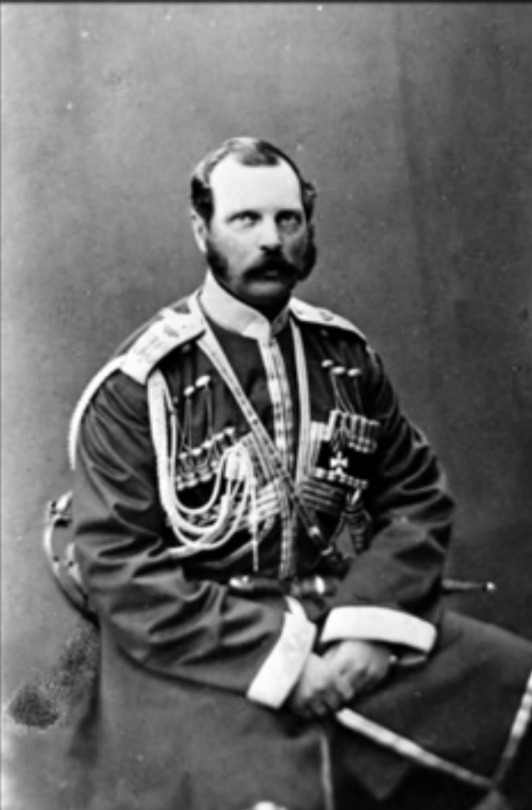


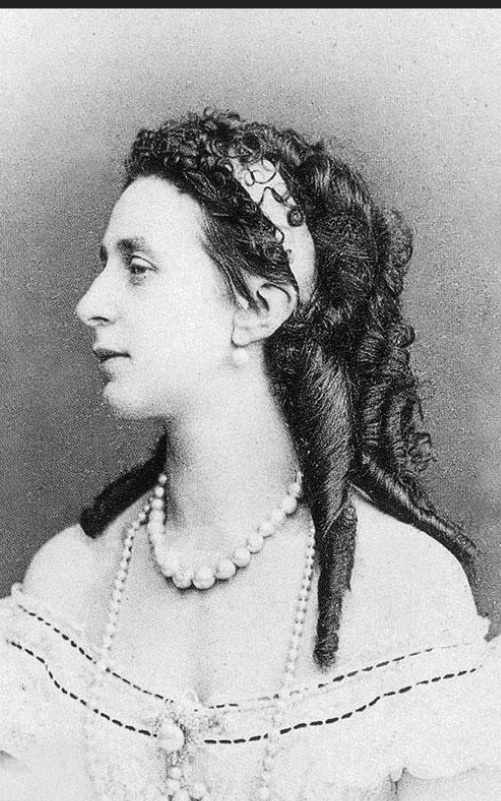

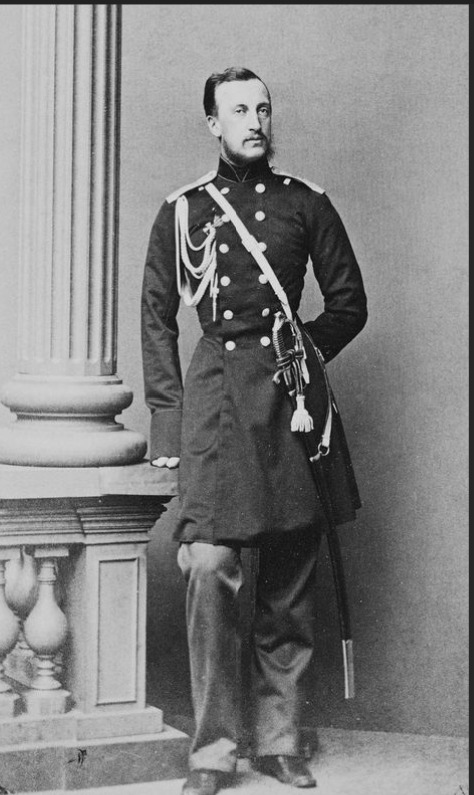

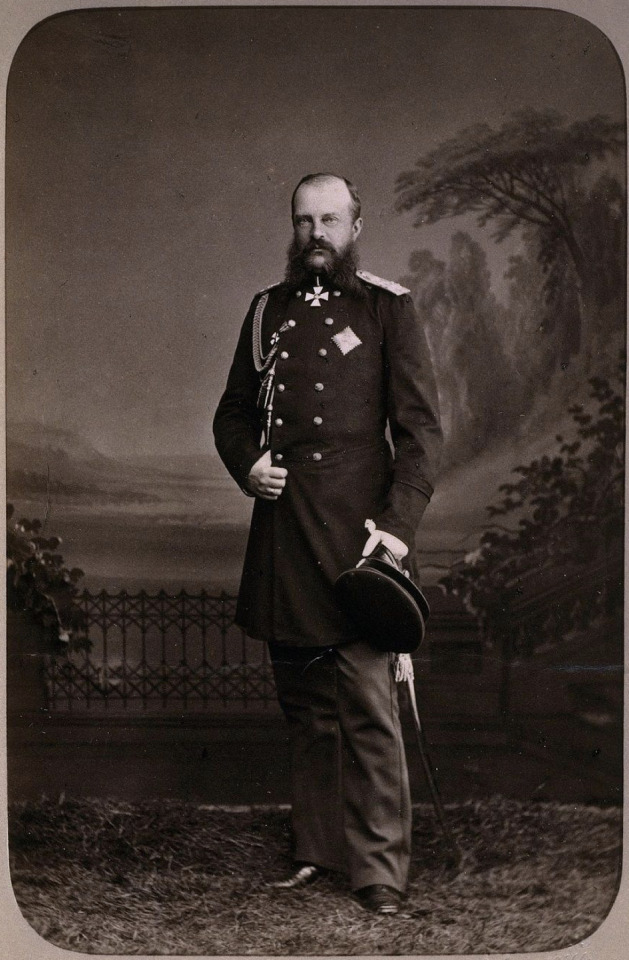
1. Emperor Alexander II and his first wife Empress Maria Alexandrovna (born Princess Wilhemine Marie of Hesse); Issue listed below (Only legitimate issue surviving to adulthood listed; not in birth order)
Grand Duchess Marie
Grand Duke Nicholas Alexandrovich
Alexander III
Grand Duke Vladimir
Grand Duke Alexei
Grand Duke Sergei
Grand Duke Pavel
2. Grand Duke Konstantin Nikolayevich and Grand Duchess Alexandra Iosifovna (Princess Alexandra of Saxe Altenburg); Issue listed below (Only legitimate issue surviving to adulthood listed; not in birth order) - They would be known as the "Konstantinovichi"
Grand Duke Nicholas
Grand Duke Konstantin
Grand Duke Dmitry
Grand Duke Vyacheslav
Grand Duchess Olga
Grand Duchess Vera
3. Grand Duke Nikolay Nikolayevich (the Elder) and Grand Duchess Alexandra Petrovna of Russia, born Duchess Alexandra Frederica Wilhelmina of Oldenburg. Issue listed below (Only legitimate issue surviving to adulthood listed; not in birth order); Known as the "Nikolayvichi”
Grand Duke Nicholas Nikolayevich
Grand Duke Peter Nikolayevich
4. Grand Duke Mikhail Nikolayevich and Grand Duchess Olga Feodorovna (nee Princess Cecilie of Baden) Issue listed below (Only legitimate issue surviving to adulthood listed; not in birth order) They were known as the "Mikhailovichi" (although they preferred to be called the "Michels;" the family called them the "Wild Caucasians" because they grew up in the Caucus and had strong opinions that they voiced loudly)
Grand Duchess Anastasia Mikhailovna
Grand Duke Nicholas Mikhailovich
Grand Duke Mikhail
Grand Duke George
Grand Duke Alexander
Grand Duke Sergei
Grand Duke Alexei
The children and grandchildren of these couples would be directly involved in one way or the other in the Great War, the Russian Revolution, the Civil War in Russia, and the overthrow of the monarchy and the Romanov Dynasty. Some would lose their lives, others would lose children, brothers, and spouses, and all would lose their country, status, and privileges.
#russian history#romanov dynasty#imperial russia#Emperor Nicholas I#Emperor Alexander II#Grand Duke Konstantin Nikolayevich#Grand Duchess Alexandra Iosifovna#Grand Duke Nikolay Nikolayevich#Grand Duchess Alexandra Petrovna of Russia#Grand Duke Mikhail Nikolaevich#Grand Duchess Olga Feodorovna#vintage photography
92 notes
·
View notes
Text

Currently there is no known photos of the wedding of Tsar Nicholas II of Russia and Princess Alix of Hesse and By Rhine on 14 November 1894 ( 26 November 1894 N.S.) at the Grand Church of the Winter Palace.Of course they may still be in the Russian Archives,not yet released
On 19 April 1894, Tsarevich Nikolai Alexandrovich Romanov of Russia was at the wedding of Ernst-Ludwig Grand Duke of Hesse, to their mutual cousin,Princess Victoria Melita of Saxe-Coburg and Gotha. Nicholas had also obtained permission from his parents, Tsar Alexander III and Empress Marie Feodorovna, to propose to Ernst's younger sister, Princess Alix of Hesse and by Rhine.The Emperor and Empress had initially been opposed to the match. However, Nicholas, who had first met Alix a decade earlier in St. Petersburg when Alix's sister, Princess Elisabeth of Hesse and by Rhine, married Nicholas's uncle, Grand Duke Sergei Alexandrovich Romanov of was not to be dissuaded. Furthermore, Tsar Alexander's health was beginning to fail.
Shortly after arriving in Coburg, Nicholas proposed to Alix. However, Alix, who was a devout Lutheran, rejected Nicholas's proposal, as in order to marry the heir to the throne, she would have to convert to Russian Orthodoxy.However, Alix's cousin, Kaiser Wilhelm II of Germany, who had been at the wedding, insisted that it was her duty to marry Nicholas, despite her religious scruples.Elisabeth also spoke with her, insisting that there were not that many differences between Lutheranism and Orthodoxy. At the prompting of the Kaiser, Nicholas proposed for the second time, and she accepted.
On 1 November 1894, Alexander III died at Maly Palace, Livadia, leaving twenty-six-year-old Nicholas as the next Tsar of Russia. The following day, Alix, who had arrived at Livadia several days earlier in order to receive the dying Tsar's blessing, was received into the Russian Orthodox Church as Grand Duchess Alexandra Feodorovna.Alix had apparently expressed her wish to take the name Catherine, but decided to take the name Alexandra on Nicholas's request.
Guests
The groom's family
•The Dowager Empress Marie Feodorovna of Russia ~ mother of Nicholas II
•Grand Duchess Xenia Alexandrovna Romanova of Russia ~ sister of Nicholas ll
•Grand Duke Alexander Mikhailovich Romanov of Russia ~ brother-in-law and first cousin once removed) of Nicholas II
•Grand Duke Mikhail Alexandrovich Romanov of Russia, brother of Nicholas II
•Grand Duchess Olga Alexandrovna Romanova of Russia, sister of Nicholas II
•Grand Duke Vladimir Alexandrovich Romanov of Russia ~ paternal uncle of Nicholas II
Grand Duchess Marie Pavlovna Romanova of Russia (the Elder) ~ paternal aunt by marriage of Nicholas II
•Grand Duke Kyril Vladimirovich Romanov of Russia ~ paternal first cousin of Nicholas II
•Grand Duke Boris Vladimirovich Romanov of Russia ~ paternal first cousin of Nicholas II
•Grand Duke Andrei Vladimirovich Romanov of Russia ~ paternal first cousin of Nicholas II
•Grand Duchess Elena Vladimirovna Romanova of Russia ~ paternal first cousin of Nicholas II
•Grand Duke Alexei Alexandrovich Romanov of Russia ~ paternal uncle of Nicholas II
•Grand Duke Sergei Alexandrovich Romanov of Russia ~ paternal uncle of N0icholas II
Grand Duchess Elisabeth Feodorovna Romanova of Russia ~ sisters-in-law and paternal aunt by marriage of Nicholas II
•Grand Duke Pavel Alexandrovich Romanov of Russia ~ paternal uncle of Nicholas II
•Grand Duchess Alexandra Iosifovna Romanova of Russia ~ paternal grandaunt by marriage of Nicholas II
•Grand Duke Konstantin Konstantinovich Romanov of Russia ~ first cousin,once removed of Nicholas II
•Grand Duchess Elizaveta Mavrikievna Romanova of Russia ~ first cousin once removed by marriage of Nicholas II
•Grand Duke Dmitri Konstantinovich Romanov of Russia ~ first cousin once removed of Nicholas II
•Duchess Vera of Württemberg, first cousin once removed of Nicholas II (representing the King of Württemberg)
•Grand Duke Mikhail Nikolaevich Romanov of Russia ~ paternal granduncle of Nicholas II
•Grand Duke Nikolai Mikhailovich Romanov of Russia ~ first cousin once removed of Nicholas II
•Grand Duke Georgiy Mikhailovich Romanov of Russia ~ first cousin once removed of Nicholas II
•Grand Duke Sergei Mikhailovich Romanov of Russia ~ first cousin once removed of Nicholas II
•King Christian lX of Denmark ~ maternal grandfather of Nicholas II
•King George l of the Hellenes ~ maternal uncle of Nicholas ll
•Queen Olga of the Hellenes ~ maternal aunt and first cousin once removed of Nicholas II
•Prince George of Greece and Denmark ~ first cousin of Nicholas II
•Prince Valdemar of Denmark ~ maternal uncle of Nicholas II
The bride's family
•Grand Duke Ernst-Ludwig of Hesse and by Rhine ~ brother of Alexandra Feodorovna
•Princess Irene of Prussia ~ Sister of Alexandra Feodorovna
•Prince Henry of Prussia ~ brother-in-law and maternal first cousin of Alexandra Feodorovna (representing the German Emperor)
•Edward, Prince of Wales ~ uncle of both Alexandra and Nicholas (representing the Queen of the United Kingdom)
•Alexandra,Princess of Wales ~ aunt of both Alexandra and Nicholas (representing the Queen of the United Kingdom)
•The Prince George,Duke of York ~ Alexandra and Nicholas' mutual first cousin
•Alfred,Duke and Duchess of Saxe-Coburg-Gotha ~ uncle of Alexandra Feodorovna and uncle by marriage of Nicholas ll
•Grand Duchess Maria Alexandrovna Romanova,Duchess of Saxe-Coburg-Gotha ~ aunt of Nicholas ll and aunt by marriage of Alexandra Feodorovna
•Ferdinand, Crown Prince of Romania, husband of Alexandra and Nicholas' mutual first cousin (representing the King of Romania)
Foreign Royalty
•Mecklenburg : Duke John Albert of Mecklenburg ~ second cousin once removed of Nicholas II (representing the Grand Duke of Mecklenburg-Schwerin)
•Grand Duchy of Baden : Prince Wilhelm and Princess Maria Maximilianovna of Baden, second cousin once removed of both Nicholas and Alexandra, and first cousin once removed of Nicholas II (representing the Grand Duke of Baden)
•The Duke of Leuchtenberg, first cousin once removed of Nicholas II
Prince George Maximilianovich and Princess Anastasia of Leuchtenberg, first cousin once removed of Nicholas II and his wife
•Grand Duchy of Oldenburg : Duke Alexander Petrovich and Duchess Eugenia Maximilianovna of Oldenburg, second cousin once removed and first cousin once removed of Nicholas II (cousin of the Grand Duke of Oldenburg)
•Grand Duchy of Oldenburg : Duke Peter Alexandrovich of Oldenburg ~ second cousin of Nicholas II
•Grand Duchy of Oldenburg : Duke Constantine Petrovich of Oldenburg ~ second cousin once removed of Nicholas II
•Grand Duchy of Mecklenburg-Strelitz : Duke Georg Alexander of Mecklenburg-Strelitz ~ second cousin once removed of Nicholas II (nephew of the Grand Duke of Mecklenburg-Strelitz)
•Grand Duchy of Mecklenburg-Strelitz : Duke Karl Michael of Mecklenburg-Strelitz ~ second cousin once removed of Nicholas II
•Duchy of Saxe-Altenburg Prince Albert and Princess Helene of Saxe-Altenburg ~ third cousin once removed of both Nicholas and Alexandra, and second cousin once removed of Nicholas II (representing the Duke of Saxe-Altenburg)
63 notes
·
View notes
Text
After being on my TBR (to be read) list for almost a decade, I’m currently and finally reading From Splendor to Revolution: The Romanov Women 1847-1928 by Julia P. Gelardi.
The Romanov women who are in focus in this book are Empress Maria Feodorovna (wife of Alexander III, mother of Nicholas II), Queen Olga of Greece, Duchess Maria Alexandrovna (only daughter of Alexander II) who became Duchess of Edinburgh and Duchess of Saxe-Coburg and Gotha, and the infamous Grand Duchess Maria Pavlovna the Elder.
10 notes
·
View notes
Text
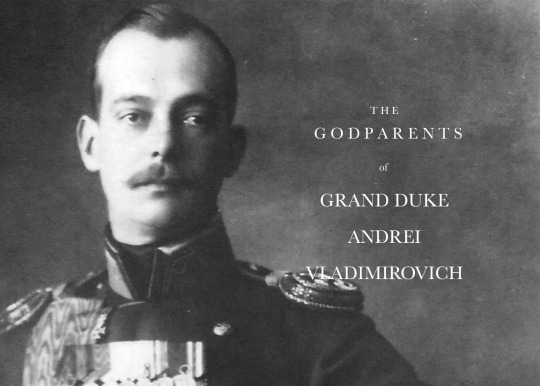
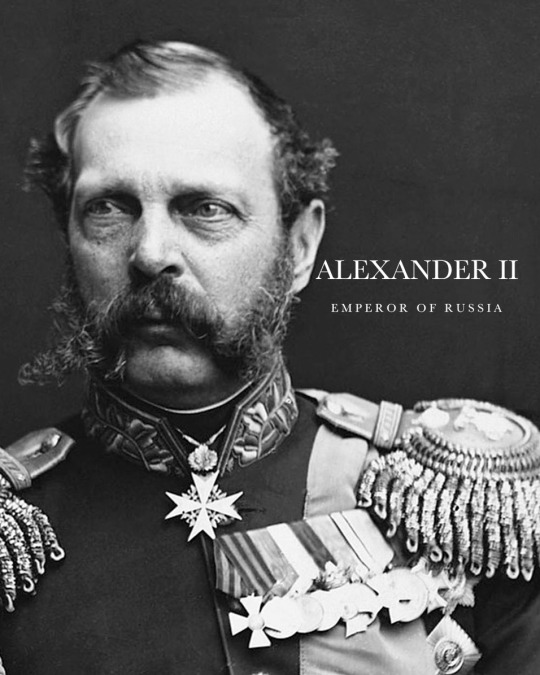



GODPARENTS OF GRAND DUKE ANDREI VLADIMIROVICH
Grand Duke Andrei Vladimirovich was born on 14 May 1879 at his parents country residence, the Vladimir Villa in Tsarskoe Selo, Saint Petersburg. He was the third surviving son of Grand Duke Vladimir Alexandrovich of Russia and his German-born wife Grand Duchess Maria Pavlova (the Elder/née Duchess of Mecklenburg-Schwerin). He was christened on 24 June at the Winter Palace by the Confessor of Their Imperial Majesties. His godparents were:
ALEXANDER II, EMPEROR OF RUSSIA - the Russian Emperor, his paternal grandfather, was one of his godparents. Alexander’s most significant reform as emperor was the emancipation of Russia’s serfs in 1861, for which he is known as Alexander the Liberator. Grand Duke Andrei was only a year-old when his grandfather was assassinated.
FREDERICK III, GERMAN EMPEROR AND KING OF PRUSSIA - then the Crown Prince, he was named as one of the godparents of the young grand duke. A first cousin of Andrei's grandfather, he became German Emperor and King of Prussia in 1888 for only 99 days.
GRAND DUCHESS ALEXANDRA PETROVNA OF RUSSIA - his great-aunt by marriage was another of Andrei's godparents. Also a Romanov by descent, she married the unpopular Grand Duke Nicholas Nikolaevich in 1856. Their marriage was an unhappy one, albeit sharing two sons. Known for her charity work, she later became a nun under the name Sister Anastasia.
ALEXANDRINE, GRAND DUCHESS OF MECKLENBURG-SCHWERIN - his maternal great-grandmother, a Prussian-born princess was another of his godparents. She was a sister of Empress Alexandra Feodorovna-consort of Nicholas I-who was also Andrei's great-grandmother on his father's side. In 1822, she married Paul Frederick, Hereditary Grand Duke of Mecklenburg-Schwerin (himself, a grandson of Tsar Paul). Their marriage was generally considered unhappy, he was a military man who had little time for or interest in his wife and family. Alexandrine, by contrast, was a devoted mother who tenderly raised her children and actively cultivated their cultural pursuits.
Source
5 notes
·
View notes
Photo

Grand Duchess Maria Pavlovna "Miechen" of Russia (14 May 1854 — 6 September 1920), better known as Maria Pavlovna the Elder, was the eldest daughter of Grand Duke Frederick Francis II of Mecklenburg-Schwerin by his first wife, Princess Augusta Reuss of Köstritz. A prominent hostess in Saint Petersburg following her marriage in 1874 to the Grand Duke Vladimir Alexandrovich of Russia, she was known as the "grandest of the grand duchesses" and had an open rivalry with her sister-in-law the Empress Maria Feodorovna.
#Marie of Mecklenburg-Schwerin#House Mecklenburg-Schwerin#XIX century#XX century#people#portrait#photo#photography#Black and White
60 notes
·
View notes